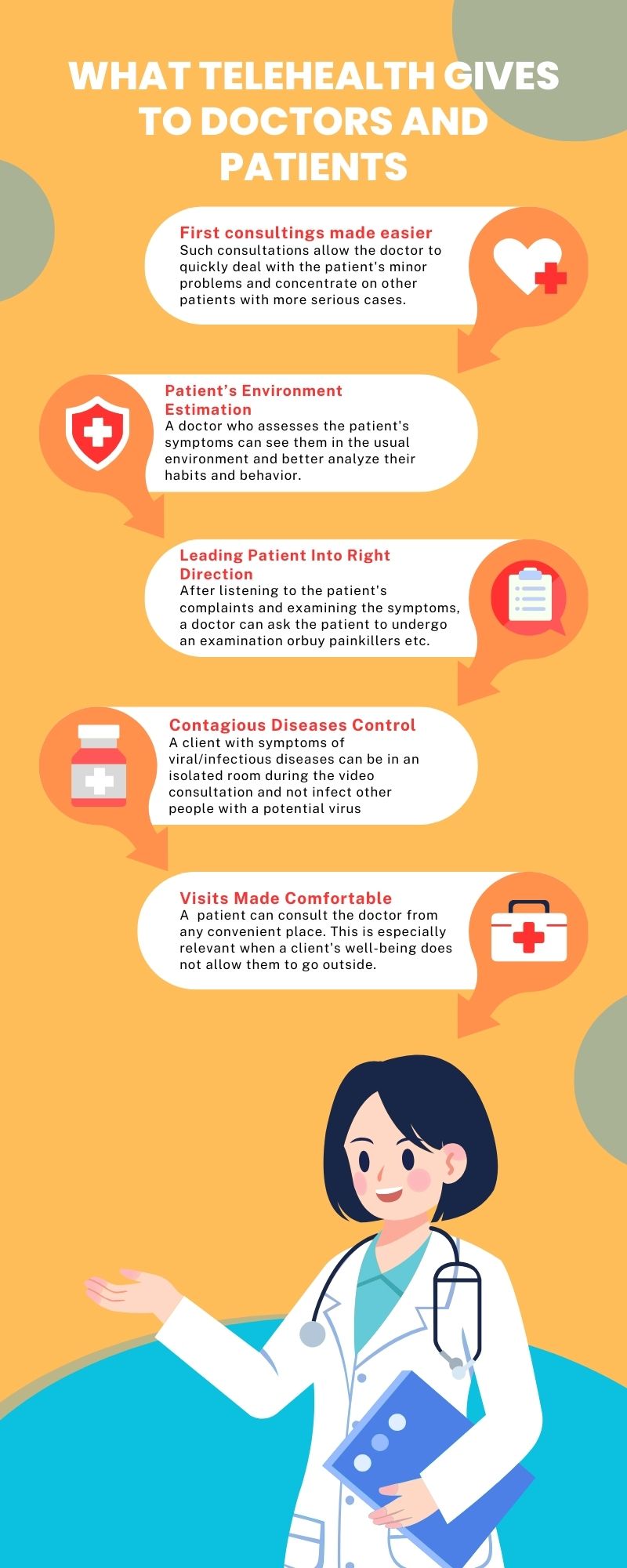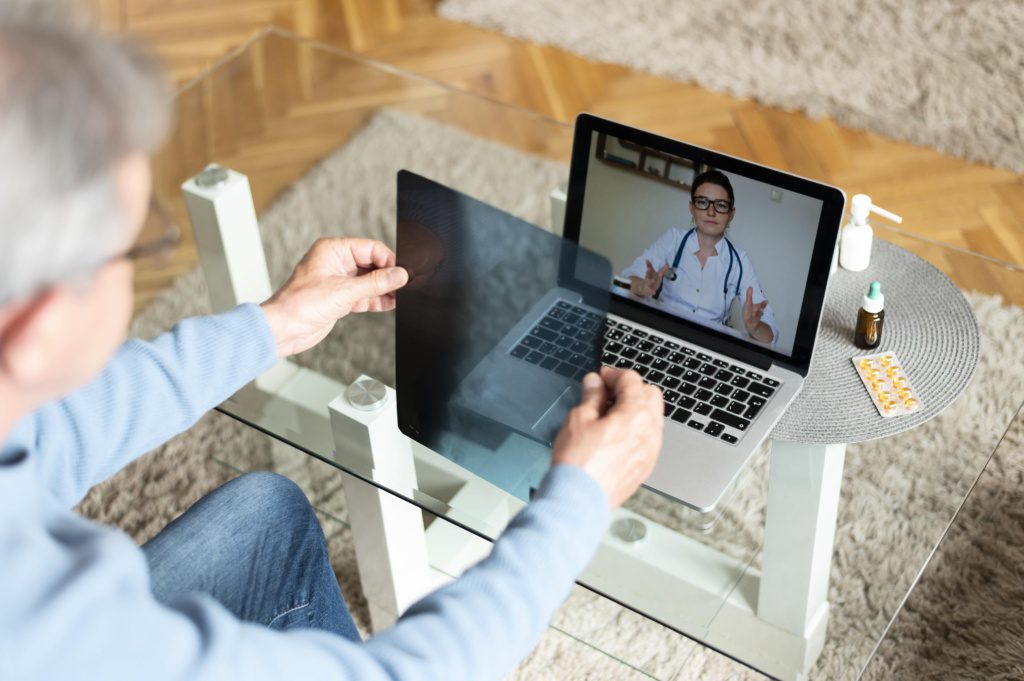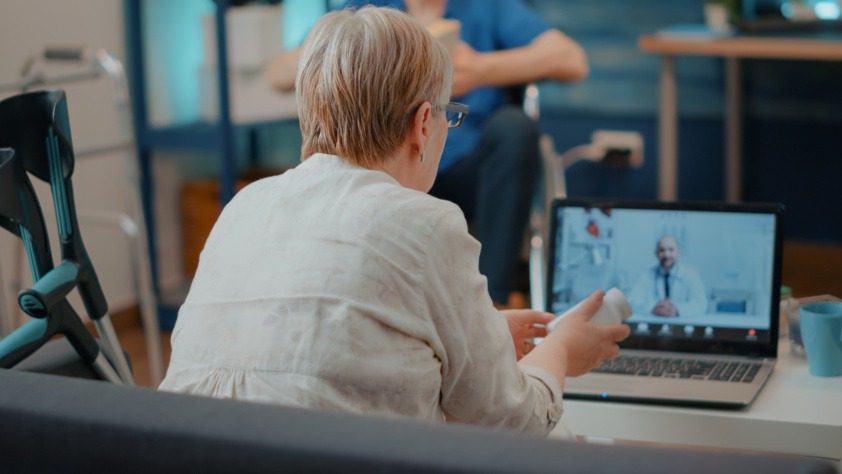Telehealth is a direction in healthcare, where modern technologies are used for preliminary consultations, diagnosis, and treatment. This IT direction was created to simplify and speed up consultations between doctors and patients, and provide more affordable professional medical services. There are several types of telehealth: remote patient monitoring, interactive patient care, and asynchronous transfer of patient data to the doctor.
The first type of technology involves gathering the necessary medical data from the patient and their transmission to the doctor remotely and conducting video conferences. Interactive Patient Care includes modern technologies for patient monitoring and treatment in the ward. Asynchronous data transfer involves the patient directly sending such data as MRI scans, test results, X-rays, medical history, etc., but the conference itself is not conducted.
What other advantages and features for patients does telemedicine provide to doctors and patients? How do web-based telemedicine solutions help save money for doctors and patients? But how does telemedicine allow you to keep the patient’s data confidential? The answers are in a new blog post.

Telehealth’s Role in Transforming Healthcare Delivery
Exploring the Advantages of Telemedicine for Physicians
Modern medical institutions should pay attention to web-based solutions in telehealth because they bring several advantages to professional doctors, including
- More convenient provision of first consultations and diagnostics. As mentioned above, telehealth is mostly used to provide first consultations and solve simpler problems such as colds, congestion, pain relief, etc. Such consultations allow the doctor to quickly deal with a patient’s minor issues and concentrate on other patients with more serious cases.
- A patient’s usual environment assessment. A doctor who assesses the patient’s symptoms can see them in their regular environment (ie, at home) and better analyze their habits and behavior. Thus, the doctor can remotely identify a potential allergen, for example.
- First aid and ruling the patient in the right direction. Even though highly qualified professional doctors usually participate in remote consultations, they cannot make a final diagnosis and prescribe real medical treatment. However, on the other hand, after listening to the patient’s complaints and superficially examining the possible symptoms, the doctor can direct the patient in the right direction (for example, to undergo an examination by a certain specialist, buy painkillers or antibiotics, etc.).
How Telehealth Empowers Patients
In turn, telemedicine makes doctor’s consultations more comfortable for patients. Here are a few reasons why:
- Convenience of visits. A patient can consult the doctor from any place, without leaving home. This is especially relevant when a client’s well-being does not allow them to go outside. And telehealth web solutions allow patients not to wait for their turn in a real doctor’s office, but to hold an online conference at a clearly defined time.
- Infectious disease control. Based on the previous point, a client who has symptoms of ARVI or other viral/infectious diseases, can be in an isolated room during the video consultation and not infect the people around them with a potential virus.

The Financial Benefits of Telehealth
In addition to the aforementioned advantages of telehealth for doctors and patients, the introduction of information technology in health care brings considerable benefits in saving money for both the medical institution and patients. For example, patients don’t have to spend time on the road to get to the hospital where the right doctor is.
As for the representatives of medical institutions, they can save money due to the transition from paper documentation to digital format. Keeping electronic documentation related to medical confidentiality and the patient’s physical condition reduces the possibility of human error so that the doctor does not have to conduct additional diagnostics and re-prescribe new drugs.
Especially when web solutions in telehealth have reliable data protection mechanisms, which we’ll discuss in the next paragraph.
Telehealth’s Role in Protecting Sensitive Medical Records
Although the doctor and the patient are not in the same room during the video conference, modern telemedicine web solutions ensure complete privacy of the conversation with the doctor. This privacy is ensured by the medical institution, using protective protocols such as TLS or SSL, which also provide encryption of information and protection against possible interceptions. In addition, medical facilities for data protection must constantly update their software and necessarily the latest protection technologies like firewalls, VPNs, antiviruses, blockchain systems, etc.
In turn, the patient must ensure the data security from their side. Thus, they should hold their meeting with the doctor at home or in another closed room that is familiar to them. The conference should be held at home, using a separate home Wi-Fi with a password. Also, neither the patient nor the doctor should record the video conference in any way, because all the necessary meeting data is recorded and stored on the platform.

Tarka Health: Elevating Telemedicine for Patients and Doctors
Tarka Health is a telehealth platform where we have demonstrated our expertise and where we can talk about our experience in development and communication.
Let’s start with the fact that we were approached by a client who is a qualified doctor from the USA. He had neither technical documentation nor design – just an idea and examples of competitors’ web solutions. The client paid attention to us because we already had experience with other projects with online shopping and chat functions, so he chose us.
While developing this project, our project manager gathered all the requirements from the client and developed a basic work plan. The project was written from scratch and the preliminary budget for the entire thing was $23,000.
To simplify the work on the design and construction of Tarka Health, we used a ready-made template. We also focused on developing a site architecture that would be flexible, constantly evolving, and able to keep the influx of patients. In this case, we used the latest versions of Laravel and Vue.js at that time, and our developers tied Stripe to conduct financial transactions between patients and doctors.
In general, two middle-plus level developers were involved in the work. Both worked on different site functionalities (for example, one worked on authorization and the patient’s office, the other on the functionality to which the doctor had access). The total work process took our team 774 hours. You can read more about our Case Overview and the final result here.
Telehealth has proven to be a great solution for doctors and healthcare facilities, as these web-based solutions like Tarka Health provide many benefits. For example, they give access to medical care even in remote areas, shorten the waiting time for a consultation, and allow for a more objective initial examination remotely, as the doctor can see the patient through a screen in a familiar environment.
Considering how active modern technology development is, medical institutions must keep up with the times and introduce technologies that make doctors’ work easier and simplify the service of patients. Thanks to telehealth, first aid and consultation can be improved and made accessible even to those living in the most distant corners of the world.


